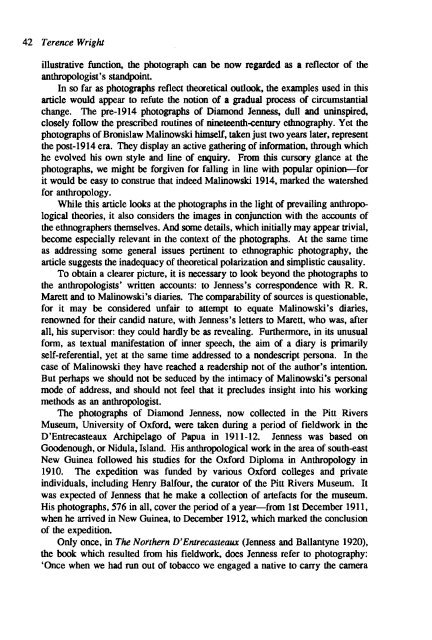1991 No. 1 CONTENTS - Institute of Social and Cultural ...
1991 No. 1 CONTENTS - Institute of Social and Cultural ...
1991 No. 1 CONTENTS - Institute of Social and Cultural ...
Create successful ePaper yourself
Turn your PDF publications into a flip-book with our unique Google optimized e-Paper software.
42 Terence WrigJu<br />
illustrative function, the photograph can be now regarded as a reflector <strong>of</strong> the<br />
anthropologist's st<strong>and</strong>point.<br />
In so far as photographs reflect theoretical outlook, the examples used in this<br />
article would appear to refute the notion <strong>of</strong> a gradual process <strong>of</strong> circumstantial<br />
change. The pre-1914 photographs <strong>of</strong> Diamond Jenness, dull <strong>and</strong> uninspired,<br />
closely follow the prescribed routines <strong>of</strong> nineteenth-century ethnography. Yet the<br />
photographs <strong>of</strong> Bronislaw Malinowski himself, taken just two years later, represent<br />
the post-1914 era. They display an active gathering <strong>of</strong> information, through which<br />
he evolved his own style <strong>and</strong> line <strong>of</strong> enquiry. From this cursory glance at the<br />
photographs, we might be forgiven for falling in line with popular opinion-for<br />
it would be easy to construe that indeed Malinowski 1914, marked the watershed<br />
for anthropology.<br />
While this article looks at the photographs in the light <strong>of</strong> prevailing anthropological<br />
theories, it also considers the images in conjunction with the accounts <strong>of</strong><br />
the ethnographers themselves. And some details, which initially may appear trivial,<br />
become especially relevant in the context <strong>of</strong> the photographs. At the same time<br />
as addressing some general issues pertinent to ethnographic photography, the<br />
article suggests the inadequacy <strong>of</strong> theoretical polarization <strong>and</strong> simplistic causality.<br />
To obtain a clearer picture, it is necessary to look beyond the photographs to<br />
the anthropologists' written accounts: to Jenness's correspondence with R. R.<br />
Marett <strong>and</strong> to Malinowski's diaries. The comparability <strong>of</strong> sources is questionable,<br />
for it may be considered unfair to attempt to equate Malinowski 's diaries,<br />
renowned for their c<strong>and</strong>id nature, with Jenness' s letters to Marett, who was, after<br />
all, his supervisor: they could hardly be as revealing. Furthermore, in its unusual<br />
form, as textual manifestation <strong>of</strong> inner speech, the aim <strong>of</strong> a diary is primarily<br />
self-referential, yet at the same time addressed to a nondescript persona. In the<br />
case <strong>of</strong> Malinowski they have reached a readership not <strong>of</strong> the author's intention.<br />
But perhaps we should not be seduced by the intimacy <strong>of</strong> Malinowski's personal<br />
mode, <strong>of</strong> address, <strong>and</strong> should not feel that it precludes inSight. into his working<br />
methods as an anthropologist.<br />
The photographs <strong>of</strong> Diamond Jenness, now collected in the Pitt Rivers<br />
Museum, University <strong>of</strong> Oxford, were taken during a period <strong>of</strong> fieldwork in the<br />
D'Entrecasteaux Archipelago <strong>of</strong> Papua in 1911-12. Jenness was based on<br />
Goodenough, or Nidula, Isl<strong>and</strong> ..' His ant.l1rQpological work in the area <strong>of</strong> south-east<br />
New Guinea followed his studies for the Oxford Diploma in Anthropology in<br />
1910. The expedition was funded by various Oxford colleges <strong>and</strong> private<br />
individuals, including Henry Balfour, the curator <strong>of</strong> the Piu Rivers Museum. It<br />
was expected <strong>of</strong> Jenness that he make a collection <strong>of</strong> artefacts for the museum.<br />
His photographs, 576 in all, cover the period <strong>of</strong> a year-from 1st December 1911,<br />
when he arrived in New Guinea, to December 1912, which marked the conclusion<br />
<strong>of</strong> the expedition.<br />
Only once, in The <strong>No</strong>rthern D'Entrecasteaux (Jenness <strong>and</strong> Ballantyne 1920),<br />
the book which resulted from his fieldwork, does Jenness refer to photography:<br />
'Once when we had run out <strong>of</strong> tobacco we engaged a native to carry the camera
















